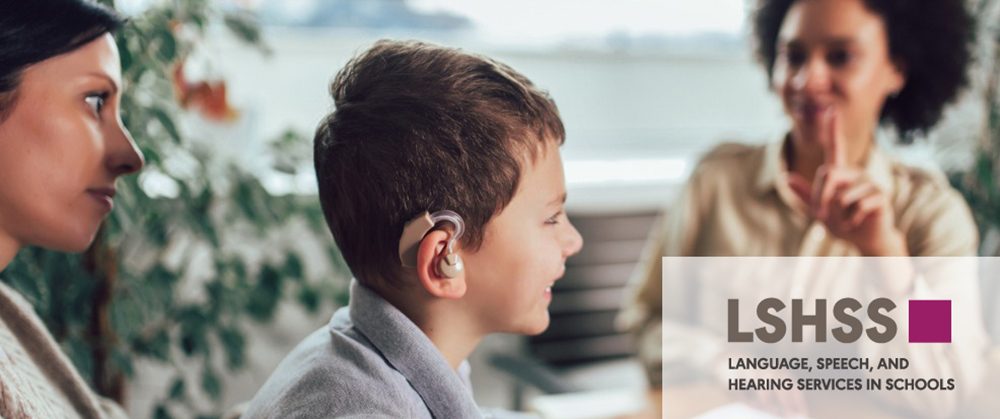Almost half of all children with permanent hearing loss have mild bilateral hearing loss (MBHL) or unilateral hearing loss (UHL; Walker, 2020); however, little research has been presented on this significant population. The latest forum from Language, Speech, and Hearing Services in Schools (LSHSS) focuses on the latest research and clinical practice for audiologists and speech-language pathologists working with these students. “There’s this gap in our knowledge of how to best serve these kids and how to support their parents,” said forum Co-Guest Editor Elizabeth A. Walker. We hope that this forum can help fill in some of those gaps.
The forum opens with a prologue by Walker, with more background information on this important topic. Next, in an article by Fitzpatrick and colleagues, researchers examine data on children with MBHL for a 14-year period after implementation of early detection and intervention. This study highlights the importance of both identifying and monitoring MBHL.
The next three articles focus on listening, language, and cognitive outcomes for children with MBHL or UHL, specifically related to high-level language comprehension. Walker and colleagues compare reading and language scores in fourth-grade children with MBHL with the scores of their peers who have normal hearing to determine if those with MBHL are at risk for language deficits. The next article by Griffin, Poissant, and Freyman examines the effects of background noise on students with UHL. Then, Al-Salim, Moeller, and McGregor compare the scores of children across a range of hearing abilities, including those with MBHL and UHL, on an audiovisual nonword repetition task.
Clinicians may not be certain when and how to treat children with MBHL or UHL, which may result in inconsistent intervention. The next three articles cover clinical practice guidelines and protocols, keeping readers apprised of the latest research. McCreery and colleagues look at a criterion for determining hearing aid candidacy in students with MBHL. Next, Bagatto discusses the evidence behind a variety of management options for children with MBHL as compared to those with UHL. Picou, Davis, and Tharpe expand on the idea that there isn’t one optimal solution for all students with UHL by providing several case scenarios focusing on nonsurgical interventions.
Of course, it’s also important to understand the effect that MBHL or UHL may have on a student. Bess and colleagues review literature showing that the increased effort these children may be expending to listen, process, and understand speech may exhaust them in the classroom. The authors then discuss a number of intervention options, while emphasizing that only limited research is available on this subject. The final article is an epilogue from Co-Guest Editor Dawna E. Lewis discussing some takeaways from the forum and focusing on the need for still more research on children with MBHL or UHL.
We’d like to thank Drs. Walker and Lewis for starting 2020 with this informative forum. We hope you enjoy the articles! If you’d like to hear more from Dr. Walker on this topic, we’ve also posted a video of her discussing the forum. You can explore the entire forum here or check out the individual articles below.
Explore the Forum
Al-Salim, S., Moeller, M. P., & McGregor, K. K. (2020). Performance of children with hearing loss on an audiovisual version of a nonword repetition task. Language, Speech, and Hearing Services in Schools, 51(1),42–54. https://doi.org/10.1044/2019_LSHSS-OCHL-19-0016
Bagatto, M. (2020). Audiological considerations for managing mild bilateral or unilateral hearing loss in infants and young children. Language, Speech, and Hearing Services in Schools, 51(1), 68–73. https://doi.org/10.1044/2019_LSHSS-OCHL-19-0025
Bess, F. H., Davis, H., Camarata, S. M., & Hornsby, B. W. Y. (2020). Listening-related fatigue in children with unilateral hearing loss. Language, Speech, and Hearing Services in Schools, 51(1), 84–97. https://doi.org/10.1044/2019_LSHSS-OCHL-19-0017
Fitzpatrick, E. M., Nassrallah, F., Vos, B., Whittingham, J., & Fitzpatrick, J. (2020). Progressive hearing loss in children with mild bilateral hearing loss. Language, Speech, and Hearing Services in Schools, 51(1), 5–16. https://doi.org/10.1044/2019_LSHSS-OCHL-19-0013
Griffin, A. M., Poissant, S. F., & Freyman, R. L. (2020). Auditory comprehension in school-aged children with normal hearing and with unilateral hearing loss. Language, Speech, and Hearing Services in Schools, 51(1), 29–41. https://doi.org/10.1044/2019_LSHSS-OCHL-19-0020
Lewis, D. E. (2020). Where do we go from here? Some messages to take forward regarding children with mild bilateral and unilateral hearing loss. Language, Speech, and Hearing Services in Schools, 51(1),98–102. https://doi.org/10.1044/2019_LSHSS-19-00075
McCreery, R. W., Walker, E. A., Stiles, D. J., Spratford, M., Oleson, J. J., & Lewis, D. E. (2020). Audibility-based hearing aid fitting criteria for children with mild bilateral hearing loss. Language, Speech, and Hearing Services in Schools, 51(1), 55–67. https://doi.org/10.1044/2019_LSHSS-OCHL-19-0021
Picou, E. M., Davis, H., & Tharpe, A. M. (2020). Considerations for choosing microphone technologies for students with limited useable hearing unilaterally. Language, Speech, and Hearing Services in Schools, 51(1), 74–83. https://doi.org/10.1044/2019_LSHSS-OCHL-19-0018
Walker, E. A. (2020). Evidence-based practices and outcomes for children with mild and unilateral hearing loss. Language, Speech, and Hearing Services in Schools, 51(1), 1–4. https://doi.org/10.1044/2019_LSHSS-19-00073
Walker, E. A., Sapp, C., Dallapiazza, M., Spratford, M., McCreery, R. W., & Oleson, J. J. (2020). Language and reading outcomes in fourth-grade children with mild hearing loss compared to age-matched hearing peers. Language, Speech, and Hearing Services in Schools, 51(1), 17–28. https://doi.org/10.1044/2019_LSHSS-OCHL-19-0015
References
Walker, E. A. (2020). Evidence-based practices and outcomes for children with mild and unilateral hearing loss. Language, Speech, and Hearing Services in Schools, 51(1), 1–4. https://doi.org/10.1044/2019_LSHSS-19-00073









